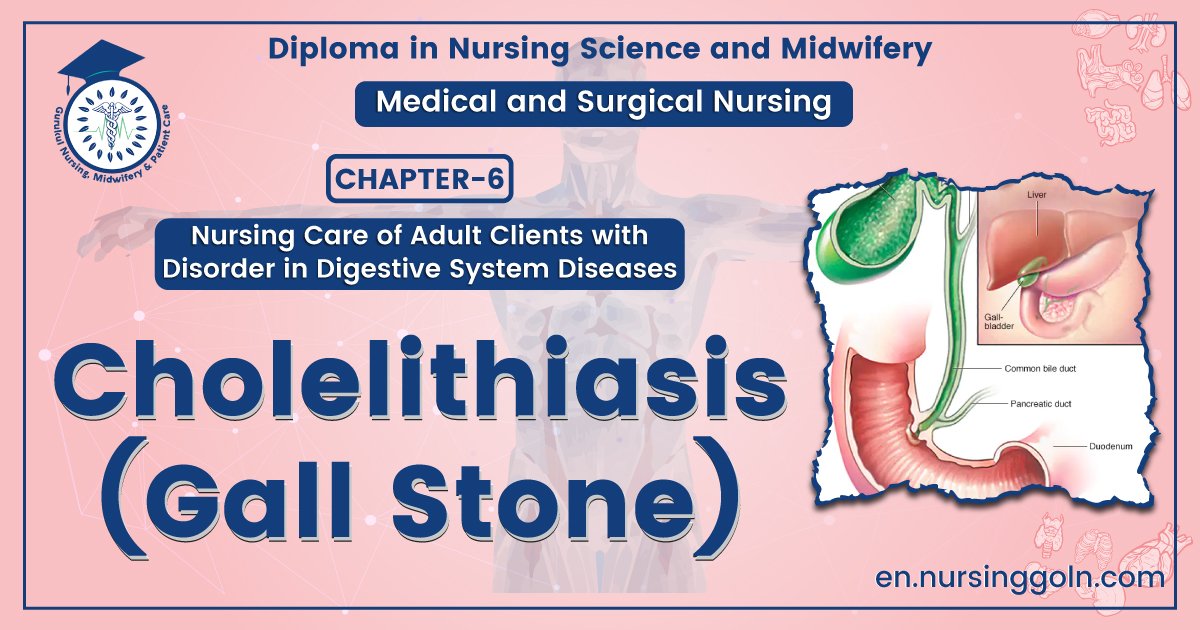Definition of Cholelithiasis – This course is designed to understand the concept of community health nursing: nurses’ roles and interventions in family health, school health, occupational health, environmental health, elderly health care, gender issues, disaster management and principles and terminology of epidemiology. The aim of the course is to acquire knowledge and skills in community health nursing.
Definition of Cholelithiasis
Cholelithiasis develop inside the gallbladder and are hard, pebble-like deposits that develop inside the gallbladder. They can be as small as a sand grain or as big as a golf ball. Complications include: Acute and chronic cholecystitis, cholangitis, choledocholithiasis, and pancreatitis. Surgery is required if the patient is symptomatic.
Or,
A gallstone is a stone formed within the gallbladder out of bile components. The term cholelithiasis may refer to the presence of gallstones or to the diseases caused by gallstones. Most people with gallstones (about 80%) never have symptoms.

Types of Cholelithiasis
There are 2 Main Types of Cholelithiasis
1. Stones which are Made of Cholesterol: These are the most common type of Cholelithiasis. Incidentally, these cholesterol gallstones are not related to the levels of cholesterol in the blood.
2. Stones which are Made of Bilirubin: These are formed during hemolysis, i.e. when the red blood cells are destroyed and this leads to excessive bilirubin production in the bile resulting in formation of this type of gallstones. These stones are also known as pigment stones.
Causes and Risk Factors of Cholelithiasis
- Women are more prone to developing Cholelithiasis.
- Certain races such as Native Americans, Hispanics are at a higher risk for developing Cholelithiasis.
- Individuals over the age of 40 are more prone to developing Cholelithiasis.
- Gallstones may also be hereditary.
Other Risk Factors Include:
- Solid organ transplant.
- Bone marrow transplant.
- Diabetes.
- Inability of the gallbladder to properly empty the bile, especially during pregnancy.
- Cirrhosis of the liver.
- Biliary tract infections cause formation of pigmented stones.
- Medical conditions such as chronic hemolytic anemia and sickle cell anemia which cause excessive production of bilirubin.
- Rapid weight loss after crash dieting or after bariatric surgery.
- Prolonged intravenous feedings.
Signs and Symptoms of Cholelithiasis
- Some patients with gallstones may not have any symptoms at all. The gallstones are discovered during routine medical procedures such as x-ray, abdominal surgery etc.
- In case of choledocholithiasis, cramping pain is present in the center to the right upper abdomen where a large stone blocks either the cystic duct or common bile duct producing a condition known as biliary colic.
- The pain subsides when the stone passes into the duodenum, which is the first part of the small intestine.
- Pain in the right upper or middle upper abdomen which may be dull, constant, sharp or cramping in nature.
- The pain may radiate to the back or below the right shoulder blade.
- Fever.
- Jaundice.
- Clay-colored stools.
- Nausea and vomiting.
Investigations
- Ultrasound of the abdomen.
- CT scan of the abdomen.
- Endoscopic retrograde cholangiopancreatography (ERCP).
- Endoscopic ultrasound.
- Gallbladder radionuclide scan.
- Percutaneous transhepatic cholangiogram (PTCA).
- Magnetic resonance cholangiopancreatography (MRCP).
- Blood tests to check for bilirubin level.
- Liver function tests.
- Pancreatic enzymes

Medical Treatment for Cholelithiasis
- Some patients with Cholelithiasis may not have any symptoms at all. The gallstones are discovered during routine medical procedures such as x-ray, abdominal surgery etc.
- Surgery is not required unless the patient is symptomatic.
- Patients who have had weight-loss surgery may also need surgery.
- The most common surgical procedure is laparoscopic cholecystectomy. Previously, open cholecystectomy (removal of gallbladder) was done for uncomplicated cases. However, this is rarely done now.
- For Cholelithiasis in the common bile duct, endoscopic retrograde cholangiopancreatography (ERCP) and sphincterotomy may be done.
- To dissolve cholesterol gallstones, medications such as chenodeoxycholic acids (CDCA) of ursodeoxycholic acid (UDCA, ursodiol) may be given in pill form. However, they take a long time to work, around two years or more and there is a chance of recurrence of the stones after the treatment.
- Sometimes, chemicals are passed into the gallbladder via catheter. These chemicals help in rapid dissolving of the cholesterol stones. This treatment is rarely done now because of its complex
nature along with the chance of the chemicals being toxic and the chance of recurrence of gallstones. - For patients who cannot have surgery, electrohydraulic shock wave lithotripsy (ESWL) of the gallbladder can be done. Although, this treatment is not used that much, as the gallstones often come back in many patients.
- Cholelithiasis cannot exactly be prevented; however, individuals who are overweight should avoid rapid weight loss to prevent gallstones.

Nursing Interventions:
- Place the patient in low Fowler’s position.
- Provide intravenous fluids and nasogastric suction.
- Provide water and other fluids and soft diet, after bowel sounds return.
- Instruct the patient to use a pillow to splint incision.
- Administer analgesic agents as ordered.
- Remind patient to expand lungs fully to prevent atelectasis.
- Promote early ambulation.
- Monitor elderly and obese patients most closely for respiratory problems,
- Place drainage bag in patient’s pocket when ambulating.
- Observe for indications of infection, leakage of bile, or obstruction of bile drainage.
- Observe for jaundice.
- Note and report right upper quadrant pain, nausea, and vomiting.
- Change dressing frequently, using ointment to protect skin from irritation.
Read more:
